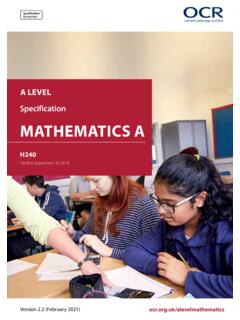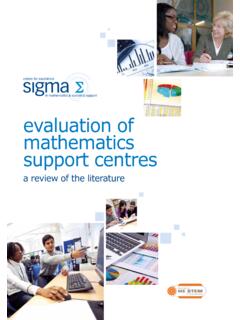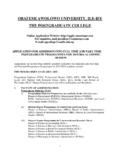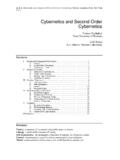Transcription of Understanding the Brain: the Birth of a Learning …
1 DE COOP RATION ETDE D VELOPPEMENT CONOMIQUESORGANISATION F OR E CONOMICCO-OPERATION AND D EVELOPMENTOECD/CERI International Conference Learning in the 21st Century: Research, Innovation and Policy Understanding the brain : the Birth of a Learning ScienceNew insights on Learning through cognitive and brain DE COOP RATION ETDE D VELOPPEMENT CONOMIQUESORGANISATION F OR E CONOMICCO-OPERATION AND D EVELOPMENT 1 Understanding THE brain : THE Birth OF A Learning SCIENCE NEW INSIGHTS ON Learning THROUGH COGNITIVE AND brain SCIENCE The following paper, taken from the recent publication of the same title, provide an overview and bring together the key messages and potential policy implications, showing how neuroscientific research is already contributing to education and Learning policy and practice.
2 The themes include discussion of lifelong Learning ; ageing; holistic approaches to education; the nature of adolescence; ages for particular forms of Learning and the curriculum; addressing the 3 Ds (dyslexia, dyscalculia, and dementia); and assessment and selection issues in which neuroscience might increasingly be involved. The chapter also points to areas needing further educational neuroscientific research that have emerged from the different chapters of the report. Overview After two decades of pioneering work in brain research, the education community has started to realise that Understanding the brain can help to open new pathways to improve educational research, policies and practice.
3 This report synthesises progress on the brain informed approach to Learning , and uses this to address key issues for the education community. It offers no glib solutions nor does it claim that brain -based Learning is a panacea. It does provide an objective assessment of the current state of the research at the intersection of cognitive neuroscience and Learning , and maps research and policy implications for the next decade. Part I The Learning brain is the main report, which is the distillation from all the analyses and events over the past seven years of the OECD/CERI Learning Sciences and brain Research project.
4 Part II Collaborative Articles contains three articles devoted to the Learning brain in early childhood, adolescence and adulthood, respectively. These have been written, in each case, by three experts who have combined their experience and knowledge in synergy of the different perspectives of neuroscience and education. Annex A reproduces some insights and dialogue that have emerged from the project s interactive website, open to civil society and including notably a teachers forum.
5 Annex B updates the reader with developments in neuroimaging technology which have proved so fundamental to the advances discussed in this report. The first chapter offers a novel ABC of the contents of the report by listing and discussing keywords in alphabetical order. This serves both to give short summaries of complex concepts and to steer the reader towards the relevant chapter(s) providing the more in-depth coverage. This is followed in the first half of the following chapter by a short but essential overview of the brain s architecture and functioning.
6 How the brain learns throughout life Neuroscientists have well established that the brain has a highly robust and well-developed capacity to change in response to environmental demands, a process called plasticity. This involves creating and strengthening some neuronal connections and weakening or eliminating others. The degree of modification depends on the type of Learning that takes place, with long-term Learning leading to more profound modification. It also depends on the period of Learning , with infants experiencing extraordinary growth of new synapses.
7 But a profound message is that plasticity is a core feature of the brain throughout life. 2 There are optimal or sensitive periods during which particular types of Learning are most effective, despite this lifetime plasticity. For sensory stimuli such as speech sounds, and for certain emotional and cognitive experiences such as language exposure, there are relatively tight and early sensitive periods. Other skills, such as vocabulary acquisition, do not pass through tight sensitive periods and can be learned equally well at any time over the lifespan.
8 Neuroimaging of adolescents now shows us that the adolescent brain is far from mature, and undergoes extensive structural changes well past puberty. Adolescence is an extremely important period in terms of emotional development partly due to a surge of hormones in the brain ; the still under-developed pre-frontal cortex among teenagers may be one explanation for their unstable behaviour. We have captured this combination of emotional immaturity and high cognitive potential in the phrase high horsepower, poor steering.
9 In older adults, fluency or experience with a task can reduce brain activity levels in one sense this is greater processing efficiency. But the brain also declines the more we stop using it and with age. Studies have shown that Learning can be an effective way to counteract the reduced functioning of the brain : the more there are opportunities for older and elderly people to continue Learning (whether through adult education, work or social activities), the higher the chances of deferring the onset or delaying the acceleration of neurodegenerative diseases.
10 The importance of environment Findings from brain research indicate how nurturing is crucial to the Learning process, and are beginning to provide indication of appropriate Learning environments. Many of the environmental factors conducive to improved brain functioning are everyday matters the quality of social environment and interactions, nutrition, physical exercise, and sleep which may seem too obvious and so easily overlooked in their impact on education.
















